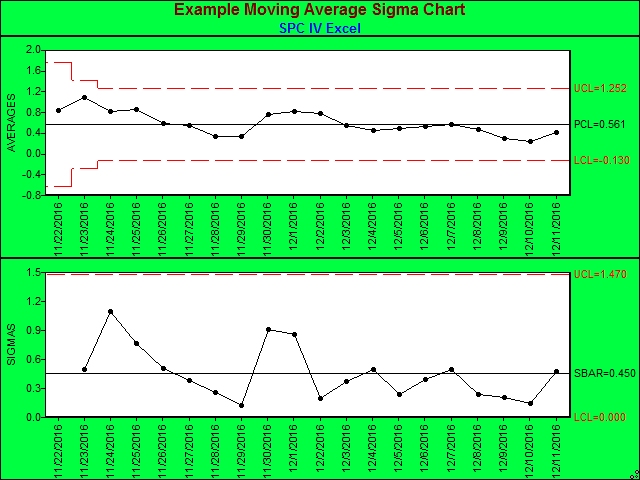Tools
Concepts
Interpretation & Calculations
Histograms, Process Capability
Applications
Key Success Factors for the Implementation of SPC
How to Study Process Capability
SPC to Improve Quality, Reduce Cost
Use Of SPC To Detect Process Manipulation
When to Use a Moving Average Sigma Chart

A Moving Average Sigma Chart from SPC IV Excel software.
As with other control charts, Moving Average Charts are used to monitor processes over time. The x-axes are time based, so that the charts show a history of the process. For this reason, you must have data that is time-ordered; that is, entered in the sequence from which it was generated. If this is not the case, then trends or shifts in the process may not be detected, but instead attributed to random (common cause) variation.
Moving Average Charts are generally used in our SPC software for detecting small shifts in the process mean. It's important to know how to use moving averages to detect small shifts in your process. Moving Average Charts will detect shifts of .5 sigma to 2 sigma much faster than Shewhart charts (i.e X-bar and Individual-X charts) with the same subgroup size. They are, however, slower in detecting large shifts in the process mean. In addition, typical run test rules cannot be used because of the dependence of data points.
Moving Average Charts may also be preferred when the subgroup size is 1. In this case, an alternative chart might be the Individual-X chart, in which case you would need to estimate the distribution of the process in order to define its expected boundaries with control limits. The advantage of Cusum, EWMA and Moving Average chart is that each plotted point includes several observations, so you can use the Central Limit Theorem to say that the average of the points (or the moving average in this case) is normally distributed and the control limits are clearly defined.
Another use of the Moving Average Charts is for processes with known intrinsic cycles, a form of autocorrelation which violates the assumed independence of subgroups required for standard Shewhart control charts. Many accounting processes and chemical processes fit into this category. If you sample at set intervals and set the cell size equal to the number of subgroups per cycle, then as you drop the oldest sample in the cell, you pick up the corresponding point in the next cycle. If the cyclical nature of the process is upset, then the new points added will be substantially different, causing out of control points.
Moving Average & Range Charts may be used when the cell size is less than ten subgroups. The Moving Average & Sigma chart can be used for any cell size, but is required for cell size ten or more.
See also:
Interpreting a Moving Average / Sigma Chart
Choosing a Control Chart for Individuals Data
Create Moving Average charts in Excel
Learn more about the SPC principles and tools for process improvement in Statistical Process Control Demystified (2011, McGraw-Hill) by Paul Keller, in his online SPC Concepts short course (only $39), or his online SPC certification course ($350) or online Green Belt certification course ($499).




